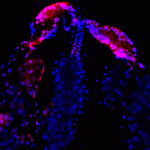Link to Pubmed [PMID] – 32368352
Link to DOI – 10.1093/ve/veaa018
Virus Evol 2020 Jan; 6(1): veaa018
Flaviviruses encompass not only medically relevant arthropod-borne viruses (arboviruses) but also insect-specific flaviviruses (ISFs) that are presumably maintained primarily through vertical transmission in the insect host. Interestingly, ISFs are commonly found infecting important arbovirus vectors such as the mosquito Aedes aegypti. Cell-fusing agent virus (CFAV) was the first described ISF of mosquitoes more than four decades ago. Despite evidence for widespread CFAV infections in A.aegypti populations and for CFAV potential to interfere with arbovirus transmission, little is known about CFAV evolutionary history. Here, we generated six novel CFAV genome sequences by sequencing three new virus isolates and subjecting three mosquito samples to untargeted viral metagenomics. We used these new genome sequences together with published ones to perform a global phylogenetic analysis of CFAV genetic diversity. Although there was some degree of geographical clustering among CFAV sequences, there were also notable discrepancies between geography and phylogeny. In particular, CFAV sequences from Cambodia and Thailand diverged significantly, despite confirmation that A.aegypti populations from both locations are genetically close. The apparent phylogenetic discrepancy between CFAV and its A.aegypti host in Southeast Asia indicates that other factors than host population structure shape CFAV genetic diversity.






